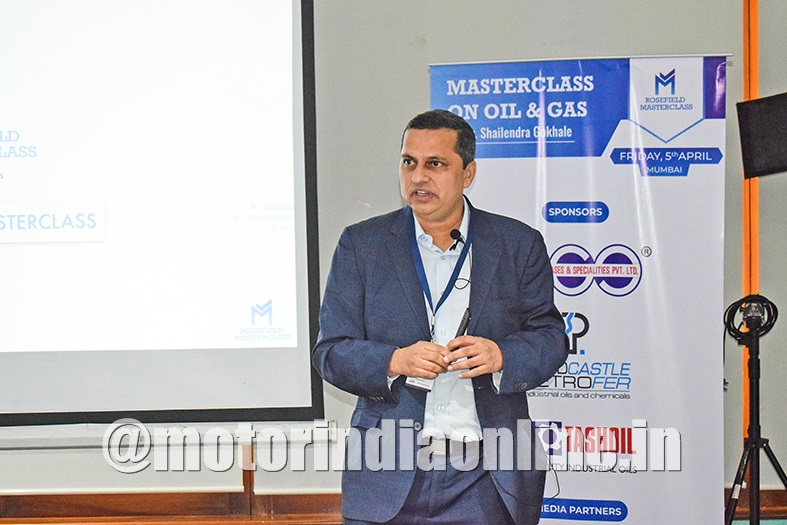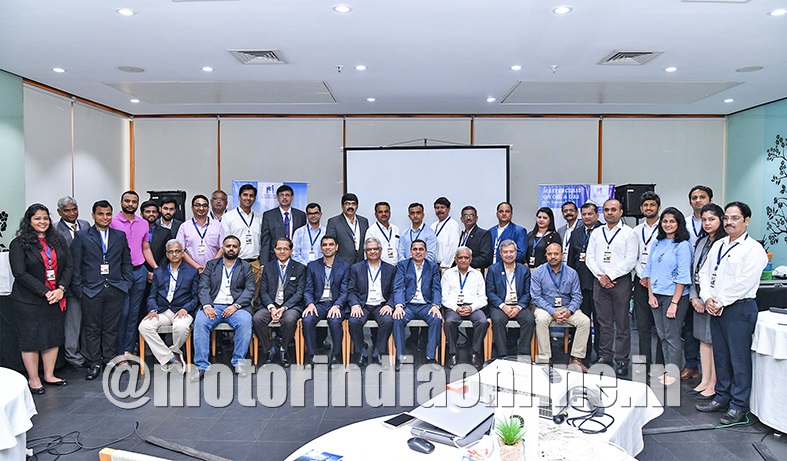Rosefield Masterclass, an initiative by Rosefield DAA International Consultancy aimed at creating a learning community who would be keen to explore various facets of an industry, subject or a concept, conducted an inaugural event on Oil & Gas in Mumbai on April 5. To flag off the initiative, the first masterclass was conducted by Mr. Shailendra V. Gokhale, Managing Partner, Rosefield DAA International Consultancy LLP, and aptly represented by participants from companies like HPCL, Clariant, Gulf Oil Lubricants India Ltd., GP Petroleums Ltd., MCX, Castrol, Infineum, Brenntag Ingredients (India) P. Ltd., Lanxess Solutions India Pvt. Ltd., and DMT International.

It is widely feared that the oil and gas sector prospects will be adversely affected, not because of depletion of stocks but due to the emergence of electric vehicles and renewable energy like solar and wind. The study is showing the trend otherwise. “You would have noticed that the masterclass was designed to address such concerns through some interesting cases and analyses. The key objective of the Masterclass was to help participants get an understanding of the fundamentals of oil and gas. This would ultimately help them invest their efforts, time and resources wisely in different forms of energy, different sectors (producing and consuming energy) and even countries, going forward,” said Mr. Gokhale, speaking exclusively to MOTORINDIA.
The Masterclass was successful in busting a lot of myths to present a clear and unbiased picture of the industry. It gave valuable insights that may be useful in making various strategic and financial decisions for organizations and individuals.
Fuel types
Looking at the types of crude and their pricing analysis, the masterclass highlighted that there are about 160 crude oils that are traded internationally. They vary in terms of their characteristics & quality. Crude oils have different special characteristics. The market value of an individual crude stream reflects its quality characteristics, mainly density and sulphur content. Density ranges from light to heavy, while sulphur content is characterized as sweet or sour. Crude oils that are light and sweet are usually priced higher than heavy, sour crude oils.
This is partly because gasoline and diesel fuel, which typically sell at a significant premium to residual fuel oil and other “bottom of the barrel” products, can usually be more easily and cheaply produced using light, sweet crude oil. The light sweet grades are desirable because they can be processed with far less sophisticated and energy-intensive processes/refineries. Reliance is the most profitable refinery in the world, which can process any type of crude and get the best margins out of it (typically $10~12 GRM against global avg. $5~6).

The presentation by Mr. Gokhale also took cognizance of crude oils from West Texas Intermediate (WTI), Brent, NYMEX Futures and OPEC baskets of crudes. He pondered upon the fact that though gas is cheaper, cleaner and is available in plenty, it is not becoming popular in cars and as transportation fuel in general. “The main barriers to this have been the short range of the vehicles, limited refueling options and slow refueling times,” he said.
On the coal front, India has the world’s largest reserves, and by ranking we stand at No.5. In terms of production, India is the largest producer of coal, after China and the US. However, we are still the largest importer, after China and Japan. Mr. Gokhale noted: “About 70% of electricity in India is produced out of coal (followed by Large Hydro). India’s local production of coal, by Coal India in 2017-18, is estimated at 600 mT & imports around 200 mT.”
Electric the way forward?
Given the consumption of crude oil, gas and coal, India’s requirement of these energies are high. The import bill of crude oil is estimated to increase by 20 per cent to $105 billion this fiscal from $88 billion in 2017-18, considering the Indian basket crude oil price of $65/bbl & exchange rate of $/Rs = 65. In volume terms, it will go up from 213 mMT to 217 mMT (by 2% only).
On the gas front, natural gas consumption in the country rose 5% to 58 billion cubic meters in 2017-18. India imports 45% of the total amount of natural gas it consumes. With the Government plan to raise the share of natural gas in the country’s energy mix to 15% by 2030 from about 6.5% now, import of LNG is expected to rise for the current 4th largest importer in the world.
Breakthrough in EV technologies, like competitive price, increased drive range and accessible recharge infrastructure are making EVs attractive options to conventional fuels. Mr. Gokhale raised a pertinent question about security of supplies of batteries. He added: “The growing need for battery intense application will increase the demand for Lithium & Cobalt. Undoubtedly, both will be new crude and gas by 2050.”
Mr. Gokhale feels that battery costs at $100/kWh will be a tipping point at which EVs will be cheaper than ICE cars, which is unlikely to happen before 2025. “The cost of the battery in 2010 was around $1000/kWH in 2010 which came down to around $230/kWH by 2017. Given the increased volumes it shall further come down.”
In a nutshell, new technologies, social preferences and Government policies will alter the way in which energy is produced and consumed in the future in ways which are impossible to predict today. “Abundant and diversified energy supplies will make for a challenging marketplace. Don’t be misguided by the recent firming in oil prices: the focus on efficiency, reliability and capital discipline is here to stay,” concluded Mr. Gokhale.